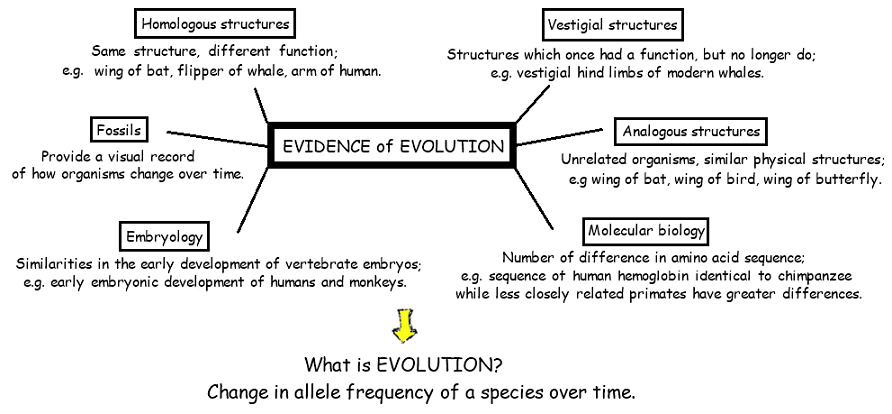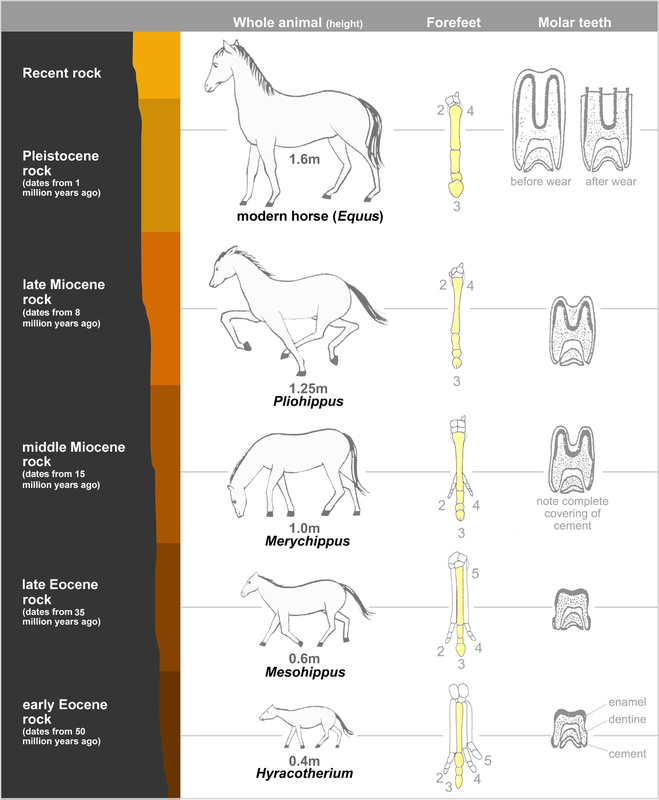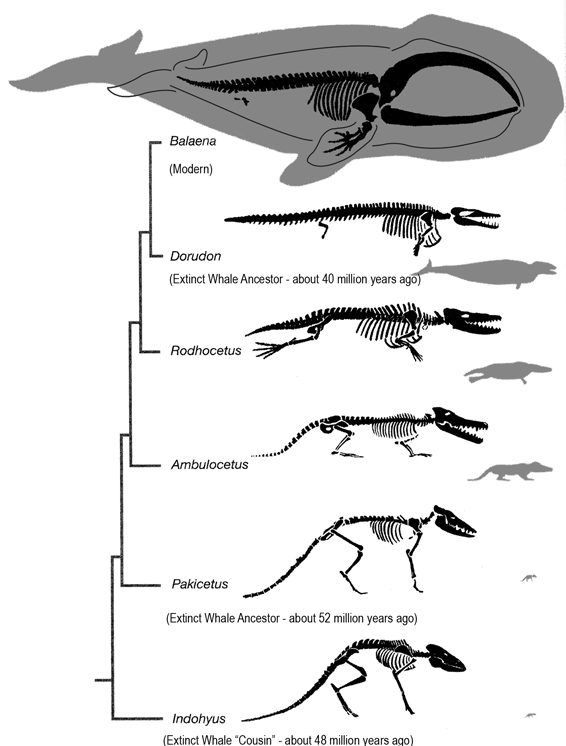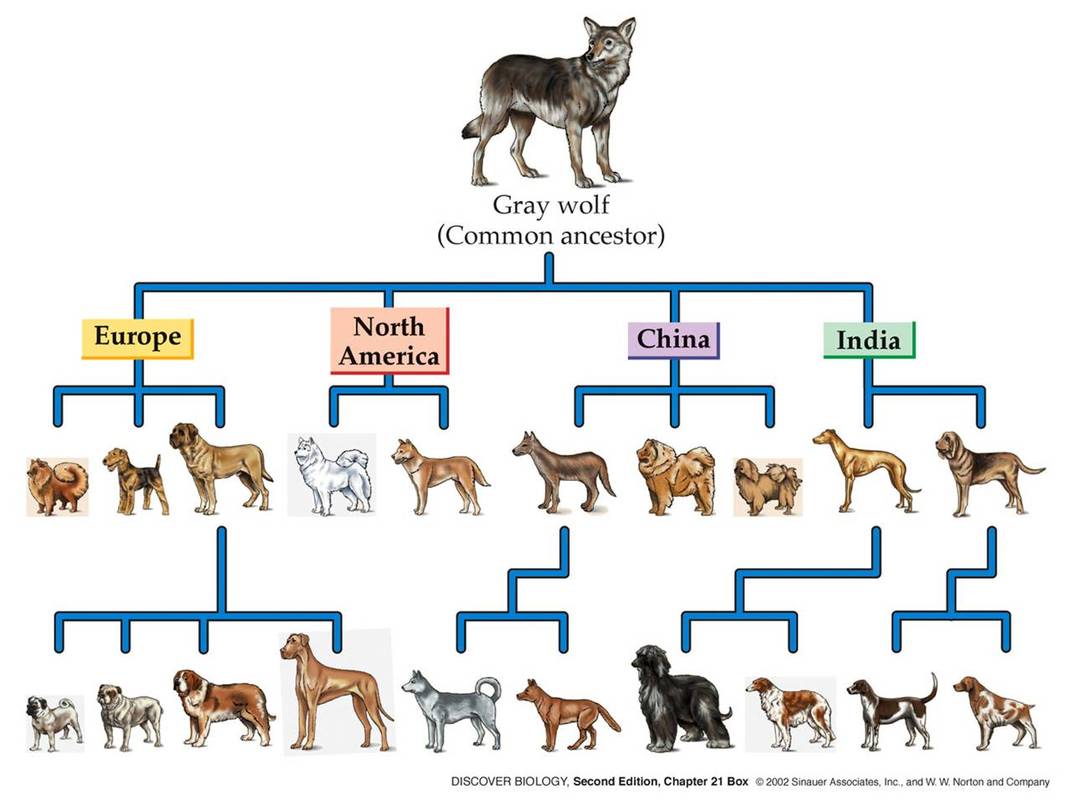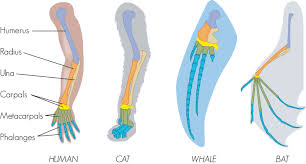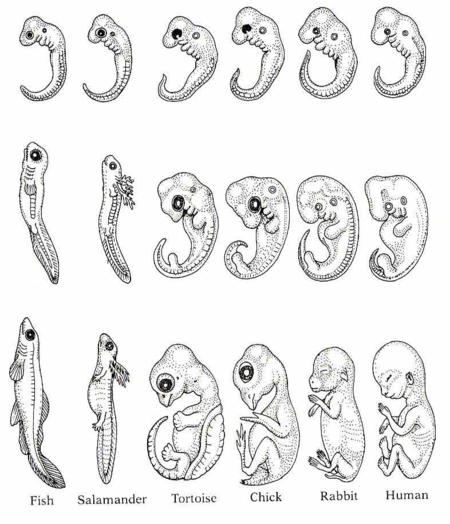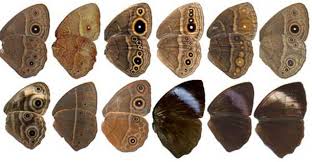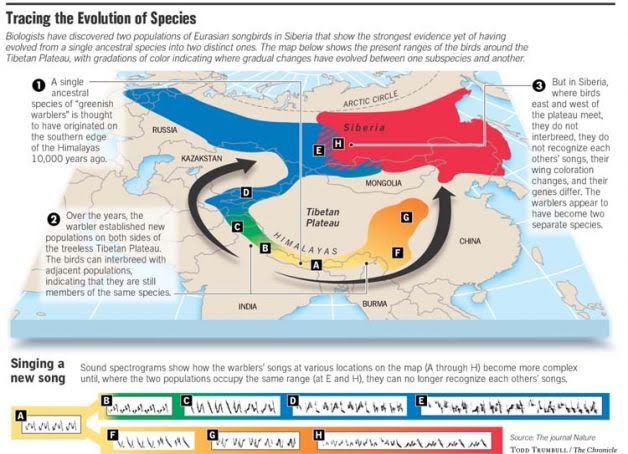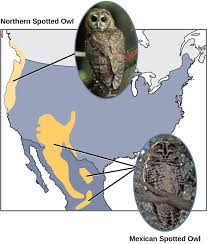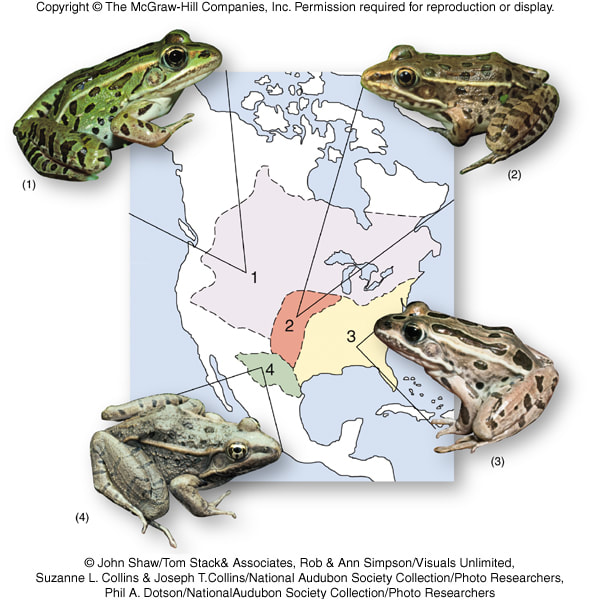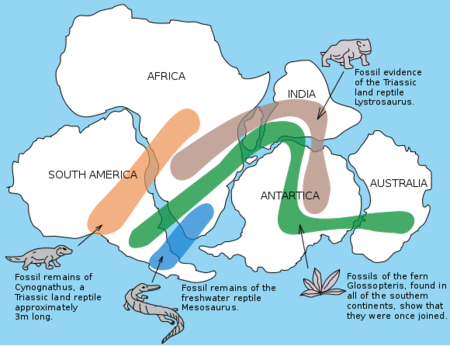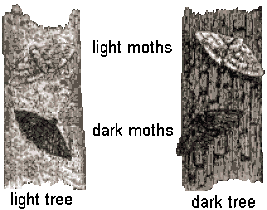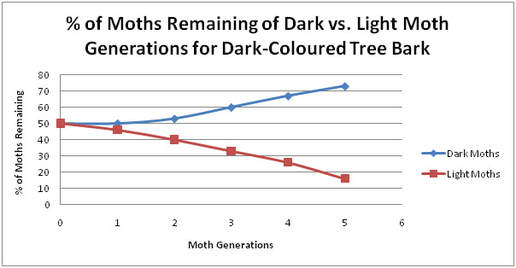image from mappingignorance.org
topic 5.1 evidence for evolution
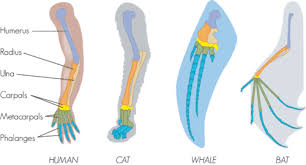
In the Evidence for Evolution unit we look at look at how time and many generations change the genetic make-up of species as they become adapted to new surroundings or altered conditions. One result of these changes may be the evolution of new varieties and species.
The unit is planned to take 2 school days.
The unit is planned to take 2 school days.
Essential idea:
- There is overwhelming evidence for the evolution of life on Earth.
Nature of science:
- Looking for patterns, trends and discrepancies—there are common features in the bone structure of vertebrate limbs despite their varied use. (3.1)
- Propose a mechanism that explains the pattern found in vertebrate limb structure yet allows for the specialization of different limb functions.
- Propose a mechanism that explains the pattern found in vertebrate limb structure yet allows for the specialization of different limb functions.
Understandings:
5.1.U1 Evolution occurs when heritable characteristics of a species change. (Oxford Biology Course Companion page 242).
- Define evolution
Evolution at its most fundamental level simply describes a change over time. In living organisms this change refers to the heritable characteristics of a species (biological evolution)
- When heritable characteristics of a species or a biological population change over successive generations
- These traits cannot be acquired over a lifetime, they are heritable traits or alleles in an organism’s DNAthe cumulative change in the heritable characteristics of a population, or
- Evolution is the change in allelic frequency in a gene pool of a population over time, as a result of natural selection, genetic drift, gene flow, and mutation pressure.
5.1.U2 The fossil record provides evidence for evolution. (Oxford Biology Course Companion page 242)
- Define strata and paleontology.
- Explain three pieces of evidence that fossils provide that evolution has occurred.
Something provides evidence for evolution when it demonstrates a change in characteristics from an ancestral form. The fossil record provides evidence by revealing the features of an ancestor for comparison against living descendants.
A fossil is the preserved remains or traces of any organism from the remote past. The preserved remains (body fossils) provide direct evidence of ancestral forms and include bones, teeth, shells, leaves, etc. Traces provide indirect evidence of ancestral forms and include footprints, tooth marks, burrows and faeces (coprolite). The totality of fossils, both discovered and undiscovered, is referred to as the fossil record. The fossil record shows that over time changes have occurred in the features of living organisms (evolution)
Fossil Record
Trilobite: http://burgess-shale.rom.on.ca/en/fossil-gallery/view-species.php?id=11&m=1&&ref=a
A fossil is the preserved remains or traces of any organism from the remote past. The preserved remains (body fossils) provide direct evidence of ancestral forms and include bones, teeth, shells, leaves, etc. Traces provide indirect evidence of ancestral forms and include footprints, tooth marks, burrows and faeces (coprolite). The totality of fossils, both discovered and undiscovered, is referred to as the fossil record. The fossil record shows that over time changes have occurred in the features of living organisms (evolution)
Fossil Record
- Fossils are the preserved remains of animals, plants, and other organisms from the past.
- The fossil record shows the gradual change of species over time.
- The timeline in which fossils appear are what scientists would expect, with bacteria and algae being the oldest in the fossil record. Followed later by shelled animals and trilobites, then dinosaurs and early reptiles, birds and mammals later still.
Trilobite: http://burgess-shale.rom.on.ca/en/fossil-gallery/view-species.php?id=11&m=1&&ref=a
- Many fossil sequences link together present day organisms with their likely ancestors. For example present day horses and zebras are closely related to tapirs and rhinos, which are all linked back to the Hyracotherium, an animal similar to the rhinoceros
- Whale evolution fossil record is also whale documented
|
Summary
|
Reliability of the Fossil Record
- Interpretation of fossil record based on differential preservation, i.e., some organisms have not been found or some locations provide necessary conditions for fossilization while other areas do not
- Bias present since not all areas of the globe have been searched for fossils, e.g. Central Asia, due to inaccessibility
- Small number (e.g. one or two) of fossils found for a species so not sure if that is a typical or atypical representation
- Gaps of time or "missing links" still exist in the fossil record
5.1.U3 Selective breeding of domesticated animals shows that artificial selection can cause evolution. (Oxford Biology Course Companion 243)
- Explain the process of artificial selection using selective breeding.
- Use an example to explain how selective breeding has lead to evolution in a species.
Selective breeding is a form of artificial selection, whereby man intervenes in the breeding of species to produce desired traits in offspring. By breeding members of a species with a desired trait, the trait’s frequency becomes more common in successive generations. Selective breeding provides evidence of evolution as targeted breeds can show significant variation in a (relatively) short period
- Breeding plants and animals for specific genetic traits.
- Shows a good record of recent changes in genetic characteristics over a few dozens of generations that man has selected to breed.
- For example, chickens that produce more eggs or cows that produce more milk are selected to breed, hopefully passing these traits onto next generations.
- Plants can be bred in a similar manner based on useful or beneficial characteristics breeders would like to see in the next generation of plants.
- The evolution of domesticated dogs has produced many different breeds through artificial selection
5.1.U4 Evolution of homologous structures by adaptive radiation explains similarities in structure when there are differences in function. (Oxford Biology Course Companion page 244)
- Contrast analogous structures and homologous structures.
- Contrast convergent evolution and adaptive radiation.
- State an example of analogous structures.
- State an example of homologous structures.
- Define vestigial structure.
- State an example of a vestigial structure
Comparative anatomy of groups of organisms may show certain structural features that are similar, implying common ancestry. Anatomical features that are similar in basic structure despite being used in different ways are called homologous structures. The more similar the homologous structures between two species are, the more closely related they are likely to be.
Homologous structures: vertebrate embryos and the pentadactyl limb.
Homologous structures: vertebrate embryos and the pentadactyl limb.
- homologous structures: various different structures sharing the same fundamental plan
- derived from a similar embryonic origin
- variations on the basic structure allow different functions
- adaptive radiation = permitting exploitation of different ways of life
- suggests divergence from a common ancestor
- common ancestor was a land animal e.g. shrew, with short five-toed limb with not specific specialization
- Modern mammal species evolved by modification of limbs to a wide variety of habitats
- Habitats can be terrestrial, aquatic and air
- i.e. running (horse) digging (moles), flying (bats) swimming ( whales) and grasping (monkey)
All species start out as single celled organisms. Many species develop into much larger, more complex organisms after conception. If we compare the embryos of animals as they develop, we often find they are much more similar than their fully developed counterparts. Many of the anatomical differences between species only arise during our embryonic development. Different species often start with the same basic tissues or structures but they develop differently and are re-purposed into different structures as the organism develops. The more closely two species are related the later in development these differences usually emerge.
5.1.U5 Populations of a species can gradually diverge into separate species by evolution. (Oxford Biology Course Companion page 244)
- Describe the process of gradual speciation.
Within a population of any given species there will be genetic variation (i.e. variation which is inheritable). Typically this variation will be continuous and follow a normal distribution curve as the rate of change is gradual and cumulative
- Within a population there is genetic variation
- If two populations of the same species become separated so that they do not reproduce or interbreed because they become separated by geographical boundaries; for example one group migrates to an island or they became separated by a mountain range, then natural selection will act differently on those two separate populations
- Over time, these populations change so that they are recognizably different and can or do not interbreed if they were to merge together again
5.1.U6 Continuous variation across the geographical range of related populations matches the concept of gradual divergence. (Oxford Biology Course Companion page 247)
- Explain how continuous variation across geographical ranges is evidence of evolutionary change.
- State an example of recognizably different populations of the same species across a geographical range.
The degree of divergence between geographically separated populations will gradually increase the longer they are separated. As the genetic divergence between the related populations increase, their genetic compatibility consequently decreases. Eventually, the two populations will diverge to an extent where they can no longer interbreed if returned to a shared environment. This process is called speciation
- When populations diverge over time and are separated, one would expect these populations to be in different stages of variation or divergence and not all separate distinct organisms right away or all the same unchanged species
- Darwin gave many of these examples that showed populations that are slightly different, but are not clearly separate species
- Examples of this are the Lava lizards and finches of Galapagos, and the Spiny Sticklebacks of BC
Biogeography is the study of species distributions. It examines how species have been distributed across different places at different times. The distribution of species shows a very clear pattern. More similar species tend to be found closer to one another geographically. The distribution of many animals and plants across different continents can be explained by continental drift (the movement tectonic plates).
The continents were once all joined together in one giant super-continent. About 200-180 million years ago the southern half called Gondwanaland broke away. This would later split into what we now know as Antarctica, Africa, Australia, South America and India.
The continents were once all joined together in one giant super-continent. About 200-180 million years ago the southern half called Gondwanaland broke away. This would later split into what we now know as Antarctica, Africa, Australia, South America and India.
Application
5.1.A1 Development of melanistic insects in polluted areas. (Oxford Biology Course Companion page 247)
- Explain how natural selection leads to changes in the melanistic variety of insects in polluted areas.
Peppered moths (Biston betularia) exist in two distinct polymorphic forms – a light colouration and a darker melanic variant
In pre-industrial revolution tree trunks in forests around major cities were light grayish-green due to presence of lichens. Most peppered moths in area are light colored with dark spots. Prior to 1850, no dark (melanic) form of moth was ever collected.
In post industrial revolution tree trunks in forests become dark due to covering with soot. (i.e. coal-based industries). After 1850, dark form of peppered moth were collected. Over the next 45 years, dark forms of moth became more common.
Melanic form of moth accounts for 95% of peppered moth population around many industrial cities in England. The mottled form accounts for largest percentage of population in non-industrial areas. This evidence shows that both formes of the peppered moth existed in the population. Brds prey upon both forms of moth when resting on tree trunks. The increase of one form over the other form (e.g. dark over light) due to bird predation (i.e. selective pressure) is an example of natural selection. Increased prevalence of melanic form of peppered moth during the Industrial Revolution is an example of a directional selection following a change in environmental conditions.
- In an unpolluted environment, the trees are covered by a pale-coloured lichen, which provides camouflage for the lighter moth
- In a polluted environment, sulphur dioxide kills the lichen while soot blackens the bark, providing camouflage for the dark moth
In pre-industrial revolution tree trunks in forests around major cities were light grayish-green due to presence of lichens. Most peppered moths in area are light colored with dark spots. Prior to 1850, no dark (melanic) form of moth was ever collected.
In post industrial revolution tree trunks in forests become dark due to covering with soot. (i.e. coal-based industries). After 1850, dark form of peppered moth were collected. Over the next 45 years, dark forms of moth became more common.
Melanic form of moth accounts for 95% of peppered moth population around many industrial cities in England. The mottled form accounts for largest percentage of population in non-industrial areas. This evidence shows that both formes of the peppered moth existed in the population. Brds prey upon both forms of moth when resting on tree trunks. The increase of one form over the other form (e.g. dark over light) due to bird predation (i.e. selective pressure) is an example of natural selection. Increased prevalence of melanic form of peppered moth during the Industrial Revolution is an example of a directional selection following a change in environmental conditions.
5.1.A2 Comparison of the pentadactyl limb of mammals, birds, amphibians and reptiles with different methods of locomotion. (Oxford Biology Course Companion page 245)
- Define pentadactyl limb.
- List the bone structures present in the pentadactyl limb.
- Identify pentadactyl limb structures in diagrams of amphibians, reptiles, birds and mammals.
- Relate differences in pentadactyl limb structures to differences in limb function.
Comparative anatomy of groups of organisms may show certain structural features that are similar, implying common ancestry. Anatomical features that are similar in basic structure despite being used in different ways are called homologous structures. The more similar the homologous structures between two species are, the more closely related they are likely to be
Vertebrate embryos:
- basic structure: the forelimbs of all tetrapods (amphibians, reptiles, birds, mammals) have the same basic pattern of 5 metacarpals and 5 phalanges arising from the same embryological structures because development is determined by many shared genes from a common a ancestor
- bats: metacarpals and phalanges elongated to support wing
- humans: slender metacarpals and phalanges with opposable thumb
- elephants: metacarpals and phalanges short and stout to support weight similar to a column
Vertebrate embryos:
- basic structure:vertebrate embryos share many similarities of body shape during early embryological development (zygote, blastocyst, body segment development., limb bud stage),
- diverging to species specific development in later embryological stages; common developmental plan arises from a set of genes inherited from a common ancestor
- salamander, chicken, pig, monkey and human all similar through limb bud stage
- differential growth produces species specific patterns during late fetal development
- gill pouches disappear during chicken, pig, monkey, and human fetal stages, but remain in salamander until adulthood
- tail remains in salamander, chicken, pig, and monkey throughout development, but is lost during human fetal development
Key Terms:
|
Darwin
common origins carbon-14 adaptive radiation humerus radius anatomical |
Wallace
natural selection artificial selection interbreed transient ulna |
evolution
DNA common ancestor polymorphism carpals pentadactyl limbs |
speciation
inheritance adaptive radiation continuous variation metacarpals articulated |
population
fossil record species divergence gradual divergence phalanges homologous |
Class Materials:
Proposing A Theory worksheet
Evolution: Constant Change and Common Threads video series on Fossils
Evolutionary Biology What is A Species Reading
Scientific America article Origins of Life .
What Evolution Is Not article
Chickens of Kuai article
Hominid Cranium Comparison Lab
Homologous Structures and Evolution activity
Homology vs Analogies worksheet
Great Fossil Find activity and resource manual
10 Vestigial Traits You Didn't Know. reading
Proposing A Theory worksheet
Evolution: Constant Change and Common Threads video series on Fossils
Evolutionary Biology What is A Species Reading
Scientific America article Origins of Life .
What Evolution Is Not article
Chickens of Kuai article
Hominid Cranium Comparison Lab
Homologous Structures and Evolution activity
Homology vs Analogies worksheet
Great Fossil Find activity and resource manual
10 Vestigial Traits You Didn't Know. reading
PowerPoint and Study Guide on Topic 5.1 by Chris Payne
Your browser does not support viewing this document. Click here to download the document.
Your browser does not support viewing this document. Click here to download the document.
Correct use of terminology is a key skill in Biology. It is essential to use key terms correctly when communicating your understanding, particularly in assessments. Use the quizlet flashcards or other tools such as learn, scatter, space race, speller and test to help you master the vocabulary.
Helpful Links:
Utah Learn Genetics: Stickleback Evolution
McGraw Hill: Mechanisms of Evolution
The pentadactyl limb by Ridley
The Complete Work of Charles Darwin Online
Darwin, Wallace and the Linnean Society
Natural History Museum: Darwin200
Evolution: Darwin's Dangerous Idea: PBS program
The Darwin Correspondence Project
Darwinians and Evolution
BBC: Historic Figures
Wilberforce and Huxley - A Legendary Encounter
The Beagle Project
Radiocarbon Dating
Evolution Lab
Movies from "evolution"
Prehistoric Life
Genetic Drift
In the News:
Scientists Discover Cosmic Factory for Making Building Blocks of Life (2013-09-15)
"Just a Theory": 7 Misused Science Words (2013-04-02)Class Material
What evolved first—a dexterous hand or an agile foot? from Phys.org
Octopuses Edit Their Genetic Code Like No Other Animal - Discover Magazine 7 April 2017
Utah Learn Genetics: Stickleback Evolution
McGraw Hill: Mechanisms of Evolution
The pentadactyl limb by Ridley
The Complete Work of Charles Darwin Online
Darwin, Wallace and the Linnean Society
Natural History Museum: Darwin200
Evolution: Darwin's Dangerous Idea: PBS program
The Darwin Correspondence Project
Darwinians and Evolution
BBC: Historic Figures
Wilberforce and Huxley - A Legendary Encounter
The Beagle Project
Radiocarbon Dating
Evolution Lab
Movies from "evolution"
Prehistoric Life
Genetic Drift
In the News:
Scientists Discover Cosmic Factory for Making Building Blocks of Life (2013-09-15)
"Just a Theory": 7 Misused Science Words (2013-04-02)Class Material
What evolved first—a dexterous hand or an agile foot? from Phys.org
Octopuses Edit Their Genetic Code Like No Other Animal - Discover Magazine 7 April 2017
TOK
- Evolutionary history is an especially challenging area of science because experiments cannot be performed to establish past events or their causes. There are nonetheless scientific methods of establishing beyond reasonable doubt what happened in some cases. How do these methods compare to those used by historians to reconstruct the past?
Brian Hare tells us the story of Dmitri Belyaev, a geneticist and clandestine Darwinian who lived in Stalinist Russia and studied the domestication of the silver fox.
Video Clips
Biologists teach that all living things on Earth are related. Is there any solid evidence to back this claim? Join us as we explore the facts! We start with a close look at the origin of whales from land mammals, and then touch on the origins of several other critters, including our own species
Professor Neil Shubin talks about the discovery of Tiktaalik and one of the greatest evolutionary events in Earth's history: when the very first fish ventured out onto land. Widely known as the "fishapod", Tiktaalik roseae is a 375 million year old fossil fish discovered by a team of six palaeontologists in the Canadian Arctic in 2004.
Learn things about a 200 million year old branch of life that would blow my mind. Get ready to meet the chillest reptile, weird living fossil, and star of Turtles All The Way Down… the tuatara
Though stickleback fish once lived in the ocean, some populations now thrive in freshwater environments. This change resulted in drastic physical transformations. Explore topics in gene expression and adaptation in this fascinating short film.
Hank gets real with us in a discussion of evolution - it's a thing, not a debate. Gene distribution changes over time, across successive generations, to give rise to diversity at every level of biological organization.
Paul Andersen discusses scientific evidence of the origin of life on our planet. He begins with a brief discussion of the age of the earth and ends with the future of humanity. He includes geologic, chemical and molecular data.
Darwin's theory of biological evolution helps us understand how simple life forms can give rise to complex lifeforms, but how did the first reproducing creatures come about? The origin of life needs its own explanation.
"What Darwin Never Knew" offers answers to riddles that Darwin couldn't explain. Breakthroughs in a brand-new science—nicknamed "evo devo"—are linking the enigmas of evolution to another of nature's great mysteries, the development of the embryo. NOVA takes viewers on a journey from the Galapagos Islands to the Arctic, and from the explosion of animal forms half a billion years ago to the research labs of today.
Marcelo Gleiser is a world-renowned theoretical physicist and award-winning writer and educator.
With a solid understanding of biology on the small scale under our belts, it's time for the long view - for the next twelve weeks, we'll be learning how the living things that we've studied interact with and influence each other and their environments. Life is powerful, and in order to understand how living systems work, you first have to understand how they originated, developed and diversified over the past 4.5 billion years of Earth's history. Hang on to your hats as Hank tells us the epic drama that is the history of life on Earth.
In a single year, there are 200-300 million cases of malaria and 50-100 million cases of dengue fever worldwide. So: Why haven't we found a way to effectively kill mosquitoes yet? Hadyn Parry presents a fascinating solution: genetically engineering male mosquitoes to make them sterile, and releasing the insects into the wild, to cut down on disease-carrying species.
In the 1950s, Belyaev and his team spent years breeding the silver fox (Vulpes vulpes) and selecting only those that showed the least fear of humans.
Learn the process of selective breeding and see examples of the process on a farm.
There is a dizzying diversity of species on our planet. From genetic evidence we know that all of those species evolved from a single ancient ancestor. But how does one species split in to many? Through the evolutionary process of speciation — which begins when populations become isolated by changes in geography or by shifts in behavior so that they no longer interbreed.
Explore speciation with The Amoeba Sisters. This video discusses sympatric and allopatric speciation and covers several types of isolation types including behavioral, temporal, and habitat isolations
